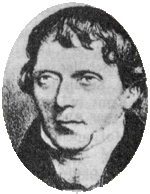Early Romantics |
|
| (1769–1843) |
Allegro
Menuetto - Trio
Adagio
Polacca - Trio
Thema con Variazioni
|
| (1763–1826) |
Allegretto
Andante con moto
Menuetto - Trio
Allegretto
|
| (1770–1836) |
Marcia poco Adagio - Allegro vivace
Larghetto
Menuetto vivace - Trio
Allegro assai
|
Hans-Georg Lickl (1769-1843) was born in Kornneuburg, Austria. He was professor of piano in Vienna, and also a noted organist. He composed many operas, and due to his appointment as principal conductor to the church of Fünfkirchen in Hungary in 1806, also of many sacred works. |
|
This quintet falls in within the great eastern european wind music tradition - it is carefree, exuberant music suitable for outdoor performance, yet skillfully worked to present each instrument to its best advantage, combining a natural lyricism with vitality and spontaneity. |
|
 |
Frans Ignaz Danzi (1763-1826) joined the famed Mannheim orchestra at the age of 15, and chose to remain in Mannheim with the newly formed Nationaltheater when the elector moved to Munich. His ambition was to write operas, but he received no commissions until 1789. However his chamber music and orchestral writing betray his longing - flowing, singing lines in the Italian operatic manner are tinged with folk melodies and given to instruments instead of voices.
Inspite of much encouragement from Weber, Danzi lead an itinerant life, searching for a sponser for his dramatic works which never eventuated. His output includes songs, religious music, orchestral and chamber music. In the true spirit of Romanticism he not only wrote his own music, but also his own libretti and poetry. Fortunately the publisher André championed his chamber music, including these nine wind quintets which form a well loved staple of the early nineteenth century quintet repertoire. |
 |
Antonín Reicha (1770-1836), although not the first to compose for the wind quintet, was undeniably the man responsible for its unique popularity during the early years of the nineteenth century. He became one of the Paris Conservatoire's most respected professors — amongst his students were Franz Liszt, Hector Berlioz, Henri Brod (oboe virtuoso and composer), Georges Onslow, Charles Gounod, Louise Farrenc (the first woman to be appointed professor of piano at the Paris Conservatoire) and Cesar Franck. He taught several generations of composers who responded to his massive output (he composed at least 28 wind quintets during his lifetime) by adding to the repertoire themselves.
He was born in Prague, but from the age of ten lived with his uncle Josef Reicha, a prominent cellist and composer at the court of the Öttingen-Wallersteins at Castle Harburg near Ansbach. In 1785 Josef Reicha and his family moved to the Court of the Elector of Cologne in Bonn where Josef took up the prestigious appointment of Kapellmeister (the Elector Maximilian Franz Habsburg was the brother of the Holy Roman Emperor, Joseph II.) Antonín was given the second flute position in his uncle's orchestra, where he met Ludwig van Beethoven (who sat at the back of the viola section) with whom he became lifelong friends. By 1795 Reicha was in Hamburg teaching piano, harmony, and composition. It was there that he read mathematics and philosophy and began to reflect seriously upon pedagogy. Giacomo Meyerbeer, Robert Schumann and Bedrich Smetana are all known to been influenced by Reicha's treatises. In 1801 he travelled to Vienna, where he was reunited with his friends Beethoven and Haydn. During his stay, Reicha came under the influence of the Mannheim School, and also that of Gluck, Haydn, and Mozart. He studied with both Albrechtsberger and Salieri. By 1808 Reicha had moved permanently to Paris where he remained until his death. Reicha's great cycle of 24 quintets were written for five professors at the Paris Conservatoire - all outstanding musicians, renowned for their virtuosity. Reicha obviously had a high level of performance in mind when writing his quintets, which are amongst the most difficult pieces in the early repertoire. The 24 published wind quintets were composed between the years 1811 and 1820. In 1815 a group was formed for the singular purpose of performing Reicha's Quintets at a series of subscription concerts. These were held in the foyer of the Théâtre Italien until 1819. These concerts were massively popular, they attracted a cult following and created a sensation; the whole of Parisian society longed to be at the first performances of the newest Reicha quintet. Reicha held a place of great honor in French society. He was welcome in the most important artistic and literary salons, and contemporary French novelists mention the performance of Reicha's wind quintets in their books. As a composer Reicha was obsessed with fugue, especially double fugue. He preferred to work with old-fashioned forms, but pushed them to their very limits; he layered polytonality, polyrhythm and the leitmotiv over the musical forms of the previous century, combining eastern european folk melodies with eighteenth century hardcore counterpoint on a symphonic scale to produce something very modern — a phenomonen which grabbed the attention of the Parisian public as well as that of its aspiring composers. |